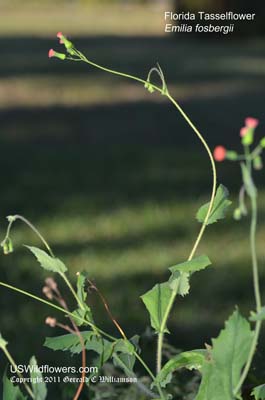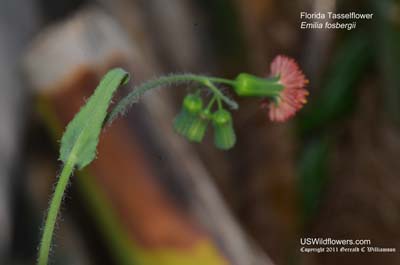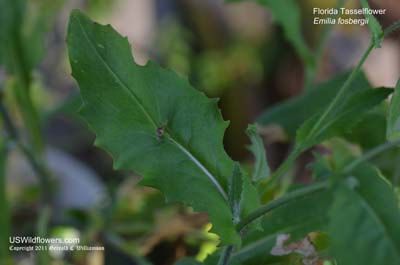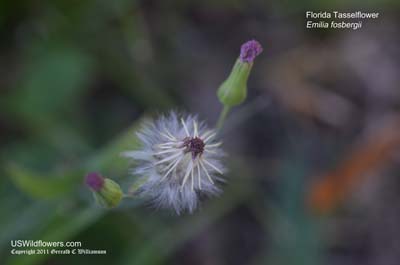Florida Tasselflower, Flora's Paintbrush, Florida Tassel Flower - Emilia fosbergii
|
Emilia fosbergii - Florida Tasselflower, Flora's Paintbrush, Florida Tassel Flower. There are three species of Tasselflower (Emilia) in the United States, none of which have very wide distribution. Lilac Tasseflower (Emilia sonchifolia) is the only native species of these three which are native (although Flora of North America disagrees with the native status of this species.) All three species are found in Florida, and Florida Tasselflower, the one presented here, is also found in Louisiana, Texas, California, and Hawaii.
E. sonchifolia is less frequent than Florida Tasselflower, and differs primarily in leaf attributes, although it usually has paler flowers.
The third species, Emilia coccinea is an ornamental that may occasionally escape but, accoring to the Flora of North America, does not persist in the wild. There is very little difference between E. coccinea and E. fosbergii (involucres are longer in fosbergii; the flower heads may be larger) but if you find it in the wild it is most likely E. fosbergii, Florida Tasselflower.
Tasselflowers do not have ray florets.
Found in:
CA, FL, HI, LA, TX
Leave comments on Emilia fosbergii at this link. | 
Distribution of Emilia fosbergii in the United States and Canada:

Blue=Native; Grey=Introduced
Map from USDA Plants Database:
USDA, NRCS. 2017. The PLANTS Database (http://plants.usda.gov, 08 May 2025). National Plant Data Team, Greensboro, NC 27401-4901 USA.
Search Our Database: Enter any portion of the Scientific, Common Name, or both.
Do a general Google search of the entire site:
#ad
 Follow USWildflowers on Twitter
#ad
| | Site: Venice, Sarasota County, FL Date: 2011-December-18 | Photographer: Gerald C. Williamson
Nikon D7000
| | The Emilia fosbergii bloomhead has no ray florets, and will typically have 50 or more disk florets. Similar species Emilia sonchifolia has fewer florets, usually 30 or less. They range in color from pinkish thru purple to red. (E. sonchifolia - Lilac Tasselflower - has paler flowers.) Florida Tasselflower may bloom year-round, but more frequently in October through March. | | 
| | Site: Venice, Sarasota County, FL Date: 2011-December-18 | Photographer: Gerald C Williamson
Nikon D7000 | | Emilia fosbergii can be more than 2 feet tall, and will usually be branched in the taller plants. The stems are somewhat weak, and can sprawl somewhat once they get taller. Emilia fosbergii will have more leaves higher on the stem (shown here) than will E. sonchifolia. | | Click on the photo for a larger image

| | Site: Venice, Sarasota County, FL Date: 2011-December-18 | Photographer: Gerald C Williamson
Nikon D7000 | | Florida Tasselflower may be without hairs, or may be hairy, as shown here. I believe the underside of this leaf (perhaps only visible on the edge of the leaf unless the photo is inspected closely) is what is described as "arachnoid-villous" in the Flora of North America – hairs appearing similar to spiderwebs. | | Click on the photo for a larger image

| | Site: Venice, Sarasota County, FL Date: 2011-December-18 | Photographer: Gerald C Williamson
Nikon D7000 | | The leaves of Florida Tasselflower are variable, but most will be more or less toothed, and may be sessile or clasping, and may have winged petioles, this example showing a clasping, toothed leaf. They may also be weakly lobed. The leaves of Lilac Tasselflower are usually petioled, and are more likely to be deeply lobed than those of Florida Tasselflower. | | Click on the photo for a larger image

| | Site: Venice, Sarasota County, FL Date: 2011-December-18 | Photographer: Gerald C Williamson
Nikon D7000 | | Florida Tasselflower seedhead. | | Click on the photo for a larger image

|
References used for identification and information:
|
|
| |
| #ad
|
|







